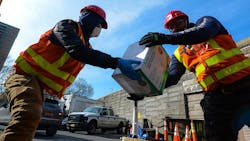New York MTA projects total coronavirus losses between $7-$8.5 billion
The Metropolitan Transportation Authority (MTA) underestimated the full financial impact of the COVID-19 pandemic by nearly half. A detailed economic study led by McKinsey & Company has determined the full economic impact to MTA will be $7 billion to $8.5 billion.
In mid-March, MTA had projected its losses associated with the COVID-19 pandemic to be upwards of $4 billion, but MTA Chairman and CEO Patrick J. Foye explains the crisis in New York has become dramatically worse, which prompted the more in depth look at the impact.
“In a few short weeks, the crisis in New York has dramatically worsened and we are projecting significant additional losses as a result of the extraordinary economic downturn facing the region and nation,” said Foye. “I thank the New York Congressional Delegation for their leadership in securing the first round of funding and we are once again asking Congress to step up and do the right thing for our millions of customers, tens of thousands of employees and for all of New York and the nation.”
MTA will receive $3.8 billion in relief from the Coronavirus Aid, Relief and Economic Security Act that was signed into law at the end of March and provides the U.S. transit industry with $25 billion for efforts to combat and recover from the virus. To account for the federal funding already committed, Foye and the MTA are asking that MTA receive an additional $3.9 billion in a future recovery stimulus package to “stem the immediate financial hemorrhaging in the MTA’s 2020 operating budget.”
How the financial impact is broken down for MTA:
- $4.7-$5.9 billion in lost toll and farebox revenues
- $1.6-$1.8 billion in lost state and local tax revenues
- up to $800 million for increased costs associated with customer and employee safety
Foye submitted a letter to New York’s 28-person Congressional delegation with the financial ask.
“In the few short weeks since I last wrote, ridership and associated revenue have continued to plummet across the system. Ridership has now declined 93 percent on the subways, 95 percent on Metro-North and 97 percent on the Long Island Rail Road, with equally reduced ridership on buses as well. We’re also seeing 62 percent fewer crossings at our bridges and tunnels,” wrote Foye.
He includes that the costs associated with customer and employee safety is expected to increase as ridership returns through the end of the year.
“Supplemental formula increases to existing transportation funding programs – which distribute dollars based on formulas that already shortchange the MTA and which do not even consider the impacts of the pandemic – do not work. We need Congress to provide a distinct funding stream to New York, the epicenter of the disaster – as it did after Superstorm Sandy – to offset the operating budget impact of the COVID-19 crisis,” wrote Foye.
Several advocacy, labor and business groups voiced their support of the request including the Partnership for New York City, TechNYC, the Transport Workers Union, the Building and Construction Trades Council of Greater New York, New York Building Congress, the General Contractors Association of NY, the Building Traders Employers’ Association, the Regional Plan Association, the Tri-State Transportation Campaign, the Riders Alliance, Transportation Alternatives, the Permanent Citizens Advisory Committee to the MTA (PCAC) and the Transportation Communications Union.
About the Author

Mischa Wanek-Libman
Group Editorial Director
Mischa Wanek-Libman is director of communications with Transdev North America. She has more than 20 years of experience working in the transportation industry covering construction projects, engineering challenges, transit and rail operations and best practices.
Wanek-Libman has held top editorial positions at freight rail and public transportation business-to-business publications including as editor-in-chief and editorial director of Mass Transit from 2018-2024. She has been recognized for editorial excellence through her individual work, as well as for collaborative content.
She is an active member of the American Public Transportation Association's Marketing and Communications Committee and served 14 years as a Board Observer on the National Railroad Construction and Maintenance Association (NRC) Board of Directors.
She is a graduate of Drake University in Des Moines, Iowa, where she earned a Bachelor of Arts degree in Journalism and Mass Communication.
